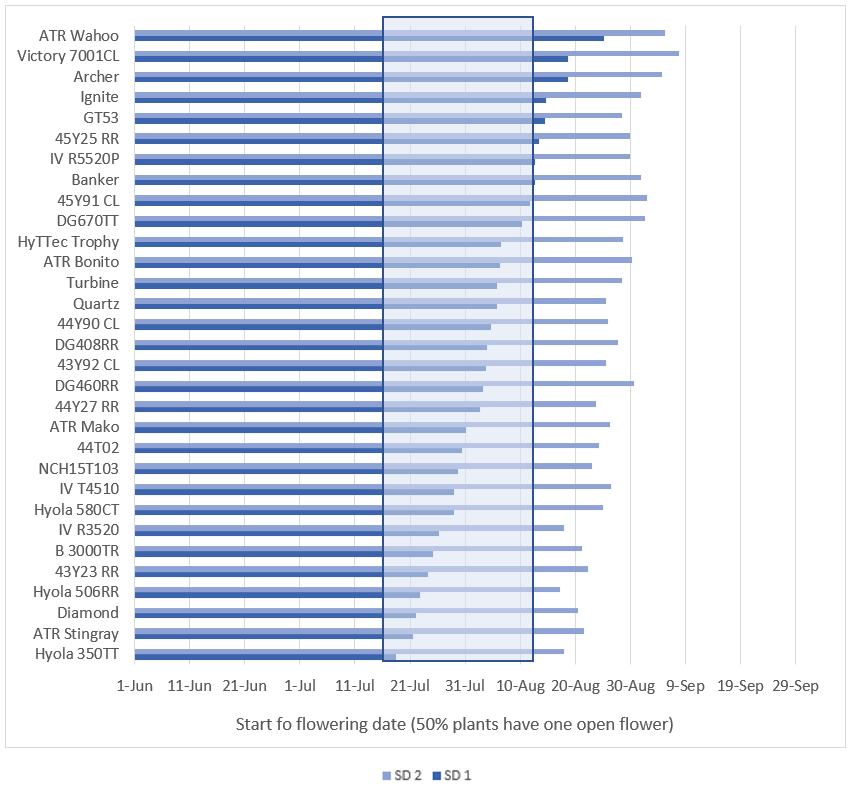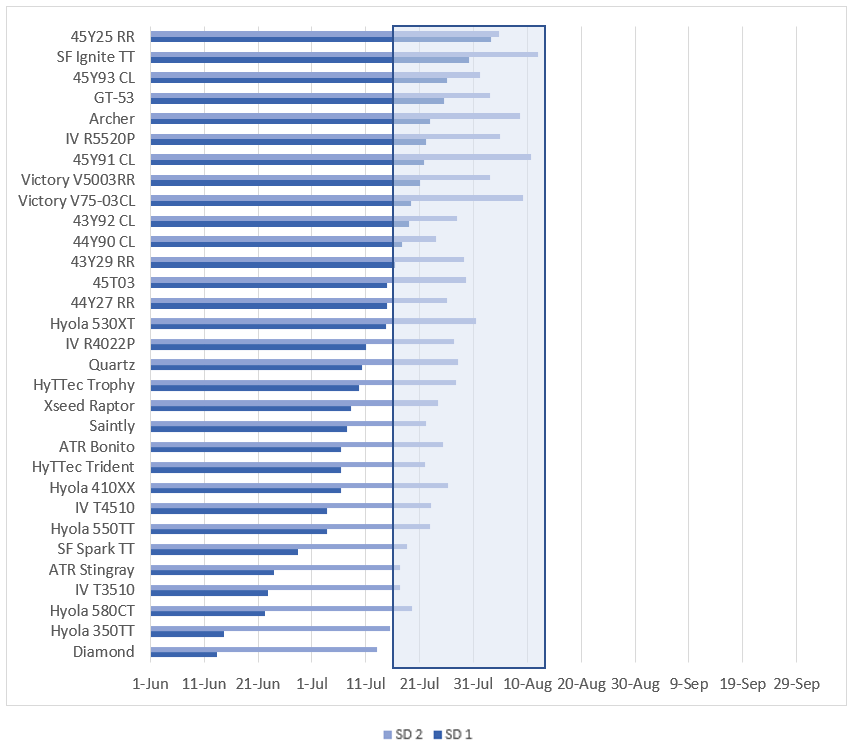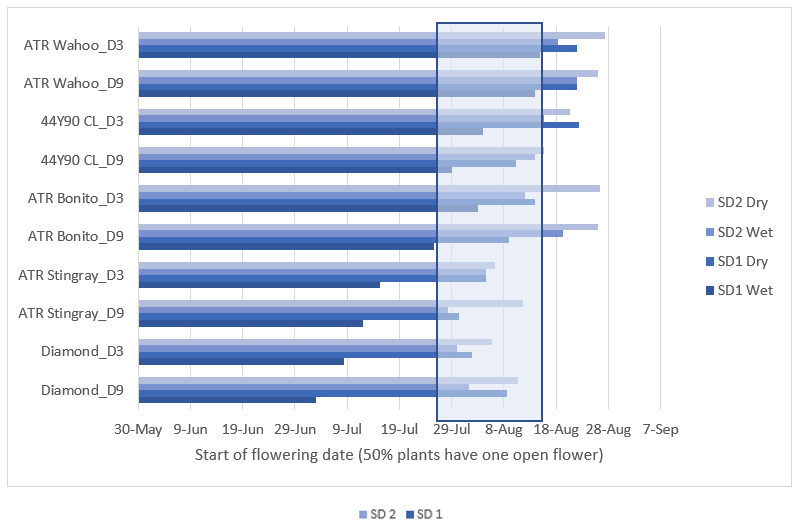Canola phenology - targeting varieties to flowering dates in different environments
Canola phenology - targeting varieties to flowering dates in different environments
Author: Danielle Malcolm (NSW DPI, Wagga), Leigh Jenkins (NSW DPI, Trangie), Rohan Brill (formerly NSW DPI) & Don McCaffery (NSW DPI, Orange) | Date: 23 Feb 2021
Take home messages
- Matching flowering date to sowing date is important to minimise the risk of plant stress caused by frost, disease, heat and lack of moisture
- Canola varieties varied markedly in the time it took from sowing to the start of flowering.
Introduction
An important management strategy to maximise yield potential for canola is to sow varieties within their correct sowing window so they start flowering within the optimum flowering period for a particular location. Flowering too early increases the risk of frost damage, upper canopy blackleg and sclerotinia stem rot infection. Flowering too late increases the risk of damage from heat or moisture stress or both, potentially reducing yield.
The optimum start of flowering (determined as 50% of the plants with one open flower) differs for each location. For Trangie, this date is between 15 July and 12 August, with the optimum date being 29 July. The optimum start of flowering for Wagga Wagga is between 31 July and 1 September, with the optimum date around 16 August. For varieties to start flowering within this period, a variety’s phenology needs to be understood so growers can sow varieties in the correct window for flowering to start during this optimum time.
Experiments at Trangie and Wagga Wagga in 2018 and 2019 and Wagga Wagga in 2020, examined the phenology of commercial and newly released varieties sown at two sowing dates. Data from trials at Trangie in 2018 and 2019 and Wagga Wagga in 2020 is presented. Phenology and yield data from an Optimised Canola Profitability experiment at Condobolin in 2018 which included five commercial varieties, two nitrogen rates with a wet and dry treatment is also included.
Treatments
Variety
Table 1 lists the details of the varieties sown across the years at Trangie and Wagga Wagga.
Table 1. Details of the varieties sown at Trangie (2018 & 2019) and Wagga Wagga (2020). 'yes' = which sites each variety was sown for those years
Variety | Phenology | Maturity | Herbicide Tolerance | Plant Type | Trangie 2018 | Trangie 2019 | Wagga Wagga 2020 |
|---|---|---|---|---|---|---|---|
Archer | Slow | Late | CLF | Hybrid | Yes | Yes | |
ATR Bonito | Mid-fast | Early | TT | Open-pollinated (OP) | Yes | Yes | Yes |
ATR Mako | Mid | Open-pollinated (OP) | Yes | ||||
ATR Stingray | Fast | Early | TT | Open-pollinated (OP) | Yes | Yes | |
ATR Wahoo | Mid-Slow | Mid | TT | Open-pollinated (OP) | Yes | Yes | |
Bayer 3000TR | Early-mid | RR/TT | Hybrid | Yes | |||
Banker CL | Hybrid | Yes | |||||
GT-53 | Mid | Mid | RR | Hybrid | Yes | Yes | Yes |
Hyola 350TT | Fast | Early | TT | Hybrid | Yes | Yes | Yes |
Hyola 410XX | Mid-fast | Early-mid | TruFlex RR | Hybrid | Yes | Yes | |
Hyola 506RR | RR | Hybrid | Yes | ||||
Hyola 530XT | Mid-fast | Mid | TruFlex RR/TT | Hybrid | Yes | ||
Hyola 540XC | Early-mid | TruFlex RR/CLF | Hybrid | Yes | |||
Hyola 550TT | Mid-fast | Mid | TT | Hybrid | Yes | ||
Hyola 580CT | Fast | Mid | CLF/TT | Hybrid | Yes | Yes | Yes |
Hyola Enforcer CT | Early-mid | CLF/TT | Hybrid | Yes | |||
Hyola Garrison XC | Early-mid | TruFlex RR/CLF | Hybrid | Yes | |||
HyTTec Trident | Mid-fast | Early | TT | Hybrid | Yes | Yes | |
HyTTec Trifecta | Mid | TT | Hybrid | Yes | |||
HyTTec Trophy | Mid | Mid | TT | Hybrid | Yes | Yes | Yes |
InVigor R 4022P | Mid-fast | Early-mid | RR | Hybrid | Yes | Yes | |
InVigor R 5520P | Mid-slow | Mid | RR | Hybrid | Yes | Yes | Yes |
InVigor R3520 | Early-mid | RR | Hybrid | Yes | |||
InVigor T3510 | Mid-fast | Early | TT | Hybrid | Yes | Yes | |
InVigor T4510 | Mid-fast | Early-mid | TT | Hybrid | Yes | Yes | Yes |
Nuseed Diamond | Fast | Early | Conventional | Hybrid | Yes | Yes | Yes |
Nuseed Quartz | Mid | Early-mid | Conventional | Hybrid | Yes | Yes | Yes |
Pioneer 43Y23 (RR) | Early | RR | Hybrid | Yes | Yes | Yes | |
Pioneer 43Y29 (RR) | Mid-fast | Early | RR | Hybrid | Yes | Yes | |
Pioneer 43Y92 (CL) | Mid-fast | Early | CLF | Hybrid | Yes | Yes | Yes |
Pioneer 44T02 (TT) | Early-mid | TT | Hybrid | Yes | |||
Pioneer 44Y27 (RR) | Mid-fast | Early-mid | RR | Hybrid | Yes | Yes | Yes |
Pioneer 44Y90 (CL) | Mid-fast | Early-mid | CLF | Hybrid | Yes | Yes | Yes |
Pioneer 44Y94 (CL) | Early-mid | CLF | Hybrid | Yes | |||
Pioneer 45T03 (TT) | Mid-fast | Mid | TT | Hybrid | Yes | ||
Pioneer 45Y25 RR | Mid | RR | Hybrid | Yes | Yes | ||
Pioneer 45Y28 (RR) | Mid | RR | Hybrid | Yes | |||
Pioneer 45Y91 (CL) | Mid-slow | Mid-late | CLF | Hybrid | Yes | Yes | Yes |
Pioneer 45Y93 (CL) | Mid-slow | Mid | CLF | Hybrid | Yes | Yes | |
Saintly CL | Mid-fast | Early | CLF | Hybrid | Yes | Yes | |
SF Ignite TT | Mid-slow | Mid-late | TT | Hybrid | Yes | Yes | Yes |
SF Spark TT | Fast | Early | TT | Hybrid | Yes | Yes | |
SF Turbine | Early-mid | TT | Hybrid | Yes | |||
Victory V7001CL | Late | CLF | Hybrid | Yes | |||
Victory V5003RR | Mid | RR | Hybrid | Yes | |||
Victory V75-03CL | Mid-slow | Mid | CLF | Hybrid | Yes | Yes | |
Xseed Condor | Mid | RR TruFlex | Hybrid | ||||
Xseed Raptor | Mid-fast | Early-mid | RR TruFlex | Hybrid | Yes | Yes |
CLF = Clearfield, TT = Triazine tolerant, RR = Roundup Ready® protected under the Plant Breeders Rights Act 1994
Sowing dates and treatments
The first sowing date for Trangie in 2018 was in late March, however it was abandoned due to poor establishment caused by high temperatures and a rapidly drying seedbed, so an alternate sowing was done in late May. Table 2 lists the sowing dates for each year for each location.
At Condobolin in 2018, five commercial grown varieties were chosen with a wet and dry treatment. Each variety had two N rates applied a rate to suit a decile 3 rainfall year and a rate for a decile 9 rate rainfall year (Table 3).
Table 2. The sowing dates for each year at each of the locations
Trangie 2018 | Condobolin 2018 | Trangie 2019 | Wagga Wagga 2020 | |
|---|---|---|---|---|
SD 1 | 26-Apr | 5-Apr | 4-Apr | 26-Mar |
SD 2 | 23-May | 26-Apr | 26-Apr | 27-Apr |
Table 3. Treatment list for Condobolin 2018
Varieties | Water Treatment | Nitrogen Rates |
|---|---|---|
Nuseed Diamond | Dry (151mm in season) | Decile 3 (72 N Units) |
ATR Stingray | Wet (307mm in season) | Decile 9 (150 N Units) |
ATR Bonito | ||
Pioneer 44Y90 (CL) | ||
ATR Wahoo |
Results
Phenology
In 2018 at Trangie, the earliest varieties to start flowering from the 26 April sowing date were Hyola 350TT, ATR Stingray and Nuseed Diamond, with these varieties flowering at the start of the optimum flowering period of 15 July. Hyola 580CT and InVigor T4510 flowered right on the optimum date of 29 July from the 26 April sowing (Figure 1). From this same sowing date, the long season varieties ATR Wahoo and Victory V7001CL flowered outside the optimum flowering window by up to 13 days. From the later sowing date of the 23 May in 2018, all varieties flowered after the optimum start of flowering period. The short season varieties, Hyola 350TT, ATR Stingray and Nuseed Diamond reached start of flowering between the 18 August and 21 August. The late season varieties did not start flowering until early September, placing them at a high risk of heat stress (Figure 1).
The first sowing date for Trangie in 2019 was 4 April, the second sowing date 26 April. Nuseed Diamond and Hyola 350TT were the first to flower on 13 and 14 June, well before the optimum start date for Trangie. Varieties flowering this early puts them at a higher risk of frost damage, upper canopy blackleg infection and sclerotinia stem rot. The late maturing varieties were the only ones to start flowering after 15 July from the 4 April sowing date, with SF Ignite TT flowering closest to the optimum date of 29 July. From the late sowing date of 26 April, all early–mid, mid and late season varieties flowered within the optimum start of flowering period. The early season variety Nuseed Diamond started flowering just outside the optimum period between on the 15 July. (Figure 2).
Nuseed Diamond was the first to flower from the 26 March sowing at Wagga Wagga in 2020, flowering on the 13 June, 48 days before the optimum start of flowering period of the 31 July. The only varieties to flower after the 31 July from the 26 March sowing were InVigor R 5520P, Pioneer 45Y23 (CL), Pioneer 45Y91 (CL), Pioneer 45Y28 (RR), ATR Wahoo and SF Ignite TT. ATR Wahoo and SF Ignite TT were the latest to flower on the 10 August. Delaying the sowing date to late April (27 April), the majority of varieties started flowering within the optimum start of flowering period for Wagga Wagga (31 July – 1 September), the earliest being Nuseed Diamond on 10 August. Pioneer 45Y91 (CL) was the last variety to reach start of flowering on 4 September (Figure 3).

(Some of the varieties in the figure above are protected under the Plant Breeders Rights Act 1994. Please see Table 1 for which varieties)

(Some of the varieties in the figure above are protected under the Plant Breeders Rights Act 1994. Please see Table 1 for which varieties)

(Some of the varieties in the figure above are protected under the Plant Breeders Rights Act 1994. Please see Table 1 for which varieties)
At Condobolin in 2018, Nuseed Diamond with a Decile 9 N rate and watered to achieve a total supply of 307mm (subsoil water + in-crop rainfall) was the quickest to flower from the first sowing date (5 April), flowering on 3 July, 23 days earlier than the optimum start of flowering period (26 July – 16 August). Both Nuseed Diamond and ATR Bonito with a Decile 9 N rate in the dry treatment (151mm in season rainfall), flowered close to the optimum start of flowering date of 9 August from the first sowing date, up to a month later than the watered treatment, indicating that moisture stress in plants will delay the start of flowering. In most cases, varieties in the dry treatment flowered well after those in the wet treatment, with the mid and longer season varieties (ATR Bonito from the second sowing date, Pioneer 44Y90 (CL) and ATR Wahoo) flowering outside the optimum flowering window, putting them at a high risk of heat stress (Figure 4).

(Some of the varieties in the figure above are protected under the Plant Breeders Rights Act 1994. Please see Table 1 for which varieties)
Discussion
Flowering time and therefore flowering within a particular period for a given location is one of the most important drivers of grain yield in canola. Having an understanding of a variety’s phenology and how that variety responds to temperature influences how the variety will perform in different environments and the correct sowing window in which that variety should be sown. During the leaf production stages of canola growth, varieties can be influenced by thermal time, photoperiod or vernal time, or a combination. For instance, winter varieties (not included in these experiments) need a period of vernalisation (cold temperatures) before they will switch from vegetative stages (leaf production) to reproductive stages (bud and flower production) of growth. The time taken within the reproductive stage, for buds to elongate and initiate flowers is also influenced by thermal time and photoperiod. There is no vernalisation requirement within the reproductive stage.
Although the spring varieties included at Trangie and Wagga Wagga did not require vernalisation before reproductive stages were initiated, the differences observed in flowering times show that the varieties still have different thermal and photoperiod requirements before they will begin flowering. The fast spring varieties such as Nuseed Diamond and Hyola 350TT do not require much thermal time for them to shift to reproductive stages and begin flowering. When these varieties are sown early, they can be exposed to warmer temperatures soon after sowing which increase the accumulated thermal time causing them to begin flowering earlier. In contrast, slow spring varieties such as ATR Wahoo and SF ignite TT, require a longer period of thermal time before they will begin flowering. Varieties sown in different environments will change the length of time it takes for those varieties to begin flowering. Fast springs will still be fast springs, however in a warmer environment such as Trangie, accumulated thermal time will be quicker than for a cooler environment like Wagga Wagga.
Understanding how a variety responds to thermal time and photoperiod and therefore knowing a varieties phenology will influence a grower’s decision on when to sow that variety to avoid flowering when the risk of frost, disease, heat or moisture stress is higher.
Conclusion
Canola varieties differ in their flowering times depending on where and when they are sown. Sowing a fast variety too early can lead to flowering when the risks of frost and disease are high; sowing a slow variety too late increases the risk of heat and moisture stress.
Matching a variety’s phenology to its sowing time is critical for flowering to start during the optimum flowering period for each region, which is when environmental and disease risks are balanced for the highest yield potential. More information on sowing windows to suit variety phenology can be found in the DPI’s Winter crop variety sowing guide 2020.
Further information
NSW DPI winter crop variety sowing guide
20 tips for profitable canola central and southern NSW
Acknowledgements
This experiment was part of the ‘Optimised Canola Profitability’ project, CSP00187, 2014–19. The project is a collaborative partnership between GRDC, NSW DPI, CSIRO and SARDI.
The research undertaken as part of this project was made possible by the significant contributions of growers through both trial cooperation and the support of the GRDC, the author would like to thank them for their continued support. Thank you to Warren Bartlett, John Bromfield and Tom Quinn for their technical assistance.
Contact details
Danielle Malcolm
DPI Wagga Wagga, Pine Gully Rd,
Wagga Wagga, NSW 2650
Ph: 0429 171 337
Email: danielle.malcolm@dpi.nsw.gov.au
Twitter: @daniellemalcol5
Varieties displaying this symbol beside them are protected under the Plant Breeders Rights Act 1994.
GRDC Project Code: CSP00187,
